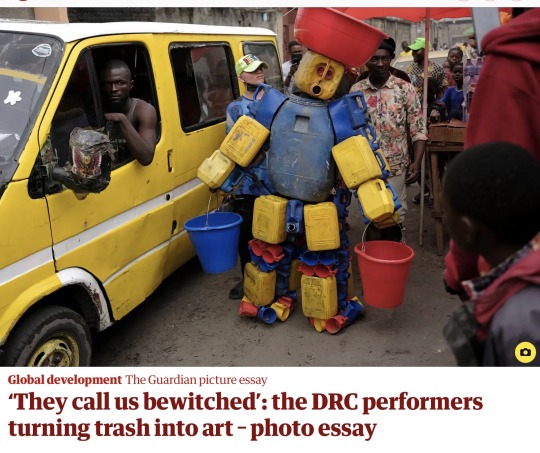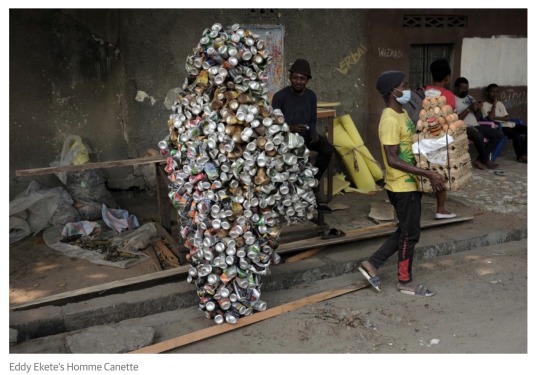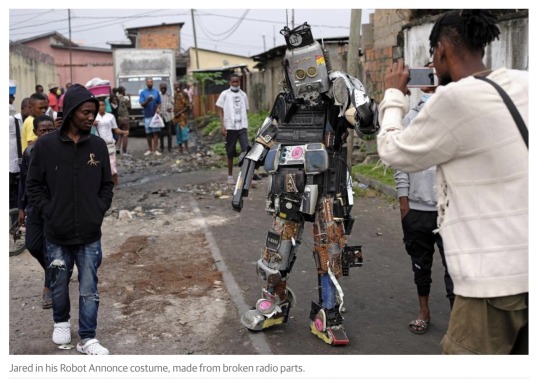#Shaka Fumu Kabaka
Explore tagged Tumblr posts
Photo

(via The Grim Gallery: Exhibit 4576)
Artist Shaka Fumu Kabaka wearing his costume, Matshozi 6 Jours (Six Days of Tears) made from discarded dolls to honour the victims of the six-day war in his home town of Kisangani, Democratic Republic of the Congo
#Shaka Fumu Kabaka#Matshozi 6 Jours#Six Days of Tears#costume#six-day war#Kisangani#Democratic Republic of the Congo
394 notes
·
View notes
Text

‘They call us bewitched’: the DRC performers turning trash into art – photo essay
Dolls found in rubbish dumps, radio parts and discarded flip-flops are among items used to create surreal costumes by a Kinshasa collective highlighting political and environmental issues
Kris Pannecoucke
Published: 07:01 Friday, 20 August 2021
As a child, Shaka Fumu Kabaka witnessed the atrocities that took place during the six-day war between Ugandan and Rwandan forces in his home town of Kisangani in June 2000.
“It was not even our war, but a war between two foreign armies,” he said.
The fighting led to more than 1,000 deaths and left many more wounded in the northern city of the Democratic Republic of the Congo. “I lost relatives,” says Kabaka.

Kabaka, 33, is one of a small but growing band of multidisciplinary artists in the country’s capital Kinshasa who create elaborate costumes from household rubbish found at dumps or on the streets. Matshozi 6 Jours (Six Days of Tears) is a surreal outfit he made from scavenged dolls to honour the victims of the six-day war.
“Every time I see a broken doll lying around somewhere in the street, it reminds me of what happened in Kisangani. They symbolise the victims I saw with my own eyes,” says Kabaka.
It took a year to collect all the dolls. “The first time I wore the costume, it was a heavy burden. Not because of the weight, but because of the number of casualties it represents.”
Kabaka can often be found at the collective Ndaku Ya La Vie Est Belle, a group of Kinshasa street performers who turn their bodies into living sculptures. The collective has found a home in the Matonge district, where the singer Papa Wemba formed his band Viva La Musica. About 20 artists turn rubbish into bizarre wearable artworks. Using their costumes as political commentary, Kabaka says his work also highlights the desperate need to recycle in a city overflowing with rubbish and plastic.
Every time I see a broken doll lying in the street, it reminds me of what happened in Kisangani
Shaka Fumu Kabaka, artist

I lived on the streets. I was homeless but I discovered art and it has given me a voice
Falonne Mambu, artist
Despite their striking appearances, the artists say they are often ignored by the city’s residents (known as Kinois) or dismissed as eccentrics. “They look at us strangely,” says Kabaka.
“[I’m a] man with Rasta haircut who collects material at the rubbish dump – the inhabitants of Kinshasa call us crazy or bewitched.”
This August, Kabaka and his fellow artists will take to Kinshasa’s streets for KinAct, a week-long arts festival. Founded in 2015 by Eddy Ekete, who was born in Kinshasa, and Aude Bertrand from France, KinAct takes place in several of the capital’s neighbourhoods. As well as street performances, the festival runs workshops to introduce children to different art forms, including theatre, sculpture, painting and poetry.

Dressed in a piece made from drinks cans, Ekete was one of the first artists to roam Kinshasa’s streets in costume. The work, Homme Canette, was inspired by artists he had met in Brazil and west Africa.
Among the artists taking part in the festival is Kalenga Kabangu Jared, a student at Kinshasa art academy. Jared regularly takes to the streets dressed as Robot Annonce. The costume, made from broken radio parts, is designed to raise awareness of fake news. “People receive so much incorrect information and many inaccuracies are spread. I want to fight this,” says Jared.

Another performer, Falonne Mambu, drew inspiration from her past when she created Femme Électrique (Electric Woman) out of electric wire. “I lived on the streets. I was homeless. But I discovered art and it has given me a voice,” says the 30-year-old.
“In the dark, the residents dare not come out of their houses. If there were light, social control would be greater, more people would be on the street. What I experienced on the streets of Kinshasa as a homeless young woman and what many girls still experience today I address through my paintings and performances. I can talk about sexual violence through my work,” says Mambu, who has worn her costume at protests against sexual violence and kidnappings.

Flory Sinanduku, a member of art collective Farata, has made a name for himself in his neighbourhood – his courtyard is full of works of art. His costumes made of medicine packages and syringes are a statement about poor healthcare in the DRC, he says.
His friend Junior Nobiko opens a bag of plastic cable coatings. “You are the first to see it,” says Nobiko proudly. “But I don’t know yet if I’ll wear it at the KinAct.”
In the street, he asks some passersby to help him wriggle in and out of his costume.

#drc#democratic republic of the congo#performance art#kinshasa#street performer#ndaku ya la vie est belle#the guardian
3 notes
·
View notes
Text
These Artists Transform Garbage into Garb to Take a Stand
In the Democratic Republic of the Congo, artists’ creations protest the country’s plight as a dump for global waste.

Tire Man, by Savant Noir, is one of the sculpture–performance art creations that protest centuries of drain on the natural resources of the Democratic Republic of the Congo, including the taking of rubber to manufacture tires. Photographs By Stéphan Gladieu
— By AyodeJi Rotinwa | May 10, 2022
It started as a countercultural art movement in 2001.
After years studying at the Academy of Fine Arts, Kinshasa—following teachers’ advice on creating work with “proper” materials, such as resin and plaster of paris—some students in the Democratic Republic of the Congo (DRC) decided to do something different. They created art with what was in their immediate environment, including tires, exhaust pipes, foam, plastic bottles, antennas, tins that had held milk or paint, feathers, CDs, rubber slippers, and other discarded items.
This work, the artists believed, felt familiar to a Congolese audience and spoke to a particularly egregious aspect of Congolese life: waste.

Left: Patrick Kitete’s Flip-Flop Man features the rubber that goes into making inexpensive shoes. Stéphan Gladieu photographed these creations for projects that he names in scientific classification form, as if the costumed figures were new species: Homo trash trash and Homo detritus.
Bottom: Mvunzi Muteba, Jr., said he designed his character, Tin Can, to raise Africans’ awareness of how multinationals’ presence has affected Africa. Despite the continent’s riches, he says, “Africans still remain poor. They expect help from foreigners,” but he insists that multinationals, in fact, come to Africa “to steal, create conflicts, [and] finance armed groups.”
Right: For several years, Gladieu has photographed Kinshasan artists wearing attire they create from rubbish—here, Shaka Fumu Kabaka dresses as Razor Man. At first reluctant to take the photo, Gladieu says he couldn’t “deny the reality” of the artist’s chosen medium: The suit is made of razor blades, which youth gang members use to ritually cut their initiates.
Waste generated locally by citizens. Waste foisted on the country by hyper-consumerist nations. Waste triggered by the endless extraction of resources from the DRC’s earth, or the rapacious collection of the same above land.
In Kinshasa, gutters are brimming with nonrecyclable plastic bottles. Markets are awash with second- and thirdhand goods, castoffs from high-income countries and, at a quickening pace, China. In areas where international companies mine for cobalt—a precious component of smartphone batteries—frequent discharges contaminate river systems and surrounding life.
By repurposing waste to create sculpture and performance art, the artists wanted to dial up the public’s acuity toward an ongoing emergency. In 2015 they laid the groundwork for a collective to institutionalize the art: Ndaku Ya Life Is Beautiful, led by Eddy Ekete. A Kinshasa-born artist and social activist, Ekete also founded the KinAct festival, an annual showcase for the provocative creations. Increasingly, for the artists, the waste provides an opening to comment on fraught sociopolitical issues.

From Left: Artists ascribe meaning to their materials. Savant Noir puts feathers, which invoke ancestors’ aid, on a Western-style suit mocking rampant consumerism. Second from left : Arnold Etabe uses plastic rings to represent viruses. Third from Left: Kilomboshi Pape Noir turned cigarette waste into the figure of Butt Man, Gladieu says, as a reminder “that although the butt is very small, it is still very polluting”—full of toxins, such as lead, formaldehyde, and arsenic, and slow to decompose. Right: Making a figure out of automobile parts was Precy Numbi’s way of protesting the millions of “garbage cars” imported into Africa every year—secondhand vehicles that discourage the growth of the continent’s own auto industry.
Robot Annonce, a wearable sculpture by Jared Kalenga, is made of broken radio parts. It seeks to raise awareness about the ever spreading reach of fake news.
Femme Électrique, Falonne Mambu’s creation made of electric wires, is double-edged. It speaks to the paucity of electric power service in the DRC and, simultaneously, what goes on in the dark: sexual assaults, kidnappings. Mambu’s inspiration for the work was drawn from periods in her life when she was homeless.
These socially conscious creators who turn refuse into protest art “are out here pushing limits,” says Yvon Edoumou, founder of Kinshasa’s Galerie Malabo. “We don’t see a lot of that.”


Left: Falonne Mambu created Femme Électrique out of a tangle of electric wires. It not only critiques the paucity of electric power service in the DRC but also illuminates dangers found in the dark: sexual assaults and kidnappings. The work was inspired by periods of homelessness in Mambu’s life. Right: Bayoka’s Cork Warrior Man features bottle-cap armor symbolizing resistance to colonialism.

Sarah Ndele made herself a suit from a gaudy variety of plastic containers and gave the character two names: Plastic Woman and Kiadi Kibeni (How Sad).



Left: Kilomboshi Pape Noir dresses as Rubber Man to pose in a Kinshasa industrial district where pollution fouls the water, soil, and air. Middle: Anita Mobando, who creates art under the name New Mama, shaped Preservation of Nature out of vegetation, as commentary on deforestation in the DRC. Right: Plastic Man, fashioned by Bestaguy Bayoka, is just one of the Ndaku Ya Life Is Beautiful collective’s artworks inspired by what Gladieu calls “the worrying invasion of plastic.”

Kitete’s Mirror Man is a dandy in a three-piece suit, according to Gladieu. He says, “The broken mirror is a reflection of what the West has inflicted on the Congo and the lives it has shattered.”
— This story appears in the June 2022 Issue of National Geographic Magazine.
1 note
·
View note